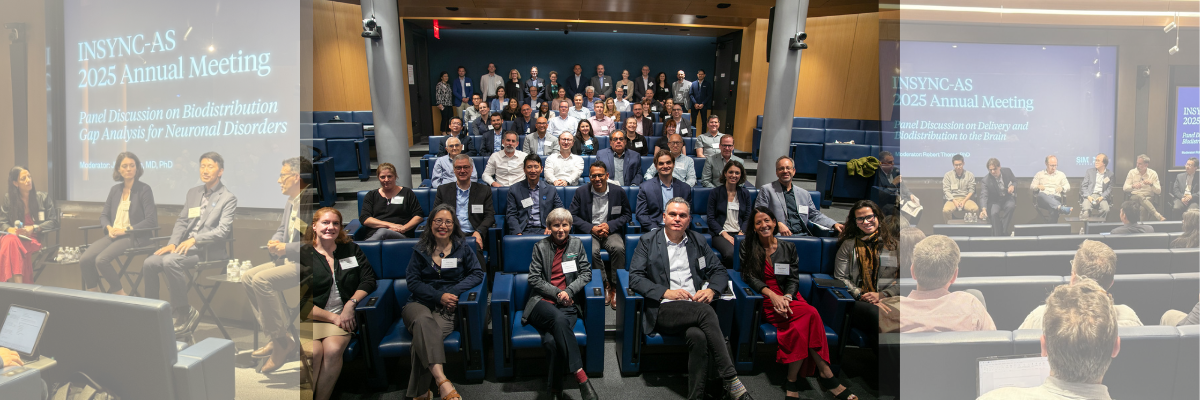
How do you administer a therapeutic to the brain, and make sure it works where it matters most? That was the question front and center at the 5th Annual International Angelman Syndrome Research Council (INSYNC-AS) Meeting, held on June 17–18, 2025 at the Simons Foundation headquarters in New York City.
This year’s meeting centered on brain-targeted therapeutic delivery and biodistribution, with a particular focus on emerging and established strategies for crossing the blood-brain barrier (BBB) and optimizing central nervous system (CNS) exposure of advanced therapeutics.
Day 1: Getting to the Brain, Smarter Delivery and Better Distribution
FAST’s Chief Science Officer, Dr. Allyson Berent, opened the day by presenting the Roadmap to a Cure and sharing the organization’s latest Angelman syndrome drug development gap analysis. These resources set the stage for the meeting’s core goal: identifying and addressing the most critical challenges in getting therapeutics safely and effectively into the brain.
The morning session focused on current clinical approaches to central nervous system (CNS) delivery, featuring:
Dr. Robert Thorne of Denali Therapeutics delivered the keynote on blood-brain barrier (BBB) physiology and how different administration routes impact therapeutic biodistribution.
Dr. Timothy Yu from Boston Children’s Hospital reviewed intrathecal delivery of antisense oligonucleotides (ASOs).
Dr. Juliette Hordeaux of GEMMA Therapeutics discussed adeno-associated virus (AAV)-mediated CNS gene therapy.
Dr. Florian Eichler from Massachusetts General Hospital shared insights into brain-targeted delivery using hematopoietic stem cell gene therapy.
The afternoon session explored next-generation CNS delivery strategies:
Dr. Kathrin Meyer of Alcoyne Therapeutics introduced intrathecal catheterization to modify delivery technique to the brain as well as implantable intrathecal devices to support repeat therapeutic delivery.
Dr. Takashi Miyamoto from Denali Therapeutics demonstrated receptor-mediated transcytosis across the BBB via transferrin receptor targeting.
Drs. Yong-Hui Jiang and Jiangbing Zhou, FAST-supported researchers, shared promising data on their STEP-RNP platform for non-viral delivery, showing promising biodistribution with both CSF and systemic administration.
Dr. Ben Deverman of the Broad Institute and Dr. Diego Garzon from Apertura Gene Therapy presented novel AAV capsids engineered for crossing the BBB in preclinical and translational studies.
Dr. Adrian Veres of Dyno Therapeutics closed the day with a review of capsid engineering strategies for BBB crossing in nonhuman primates and their translation to humans.
Day 2: Learning from Others, Natural History and Cross-Disease Innovation
The second day was focused on learnings from peer organizations that are tackling shared challenges in drug development, natural history research, and clinical trial readiness.
Presenters from Rett Syndrome Research Trust, STXBP1 Disorders Foundation, The LouLou Foundation (CDKL5 Deficiency), and SCN2A Families Foundation shared updates on their therapeutic pipelines and the role of natural history studies in informing trial design and readiness.
Dr. Xavier Logier d’Ardhuy of the LouLou Foundation presented results from the CANDID study
Sarah McKeown Ruggiero from the STXBP1 Disorders Foundation discussed the STARR study
Dr. Anjali Sadhwani of Boston Children’s Hospital shared 20 years of data from the Angelman Syndrome Natural History Study, which continues to inform clinical endpoints and trial design.
The final session featured a deep dive into the Tuberous Sclerosis Complex (TSC) Alliance:
Dr. Mustafa Sahin provided a historical and scientific overview of TSC.
Dr. Dean Aguiar detailed the TSC Alliance’s translational pipeline and infrastructure for clinical development and community engagement.
A Clear Signal: We’re Stronger Together
INSYNC-AS 2025 was widely seen as the most impactful meeting to date. It brought together leaders across research, medicine, and industry to tackle shared challenges and exchange knowledge that can drive progress not only for Angelman syndrome, but for many rare conditions that still lack effective treatments.
The insights and relationships built here help define what’s needed next, where innovation is possible, and how the field can move with greater speed and coordination. INSYNC-AS continues to demonstrate the value of collaboration across scientific, clinical, and patient-driven initiatives.